

Éveline Gallant Fournier. PROCESS: With the advent of genetically modified seeds, seed patents and terminator seeds which create sterile plants, the act of saving seeds is threatened as well as the foundamental nature of plants.
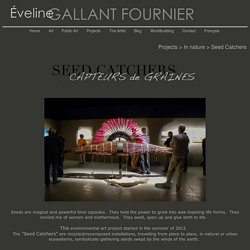
On the other hand, invasive and non indigenous plants, such as the heracleum mantegazzianum (commonly known as giant hogweed), threatens the equilibrium of ecosystems and biodiversity. It's sap is toxic. Upon contact, it can provoke second degree burns. It is not native to the Americas. Sustainable High Density. Posted on 17 February 2009.
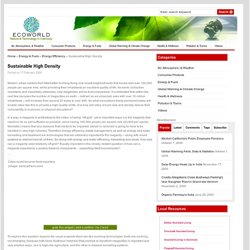
Modern urban centers from Manhattan to Hong Kong now boast neighborhoods that house well over 100,000 people per square mile, while providing their inhabitants an excellent quality of life. As world civilization voluntarily and inexorably urbanizes, new megacities will be built everywhere. It is estimated that within the next few decades the number of megacities on earth – defined as an urbanized area with over 10 million inhabitants – will increase from around 20 today to over 400. So what innovations being pioneered today will enable cities like this to provide a high quality of life, and how will cities of such size and density reduce their vulnerability to economic or physical disruptions?
It is common for the smart growth crowd to say “build up, not out,” but this misses two key points. Grow Flax For Linen In Your Garden - Organic Gardening. Growing flax to process into linen was a common activity on homesteads before the Industrial Revolution.
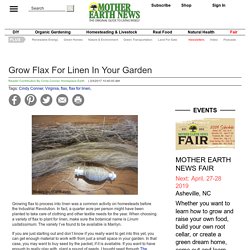
In fact, a quarter acre per person might have been planted to take care of clothing and other textile needs for the year. When choosing a variety of flax to plant for linen, make sure the botanical name is Linum usitatissimum. The variety I’ve found to be available is Marilyn. If you are just starting out and don’t know if you really want to get into this yet, you can get enough material to work with from just a small space in your garden. Moss and Stone Gardens. Mosses can be collected by scooping, scraping, or raking.
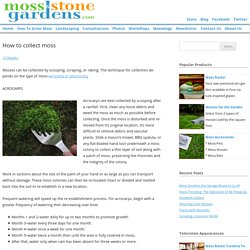
The technique for collection depends on the type of moss–acrocarp or pleurocarp Acrocarps are best collected by scooping after a rainfall. First, clean any loose debris and weed the moss as much as possible before collecting. Once the moss is disturbed and removed from it’s original location, it’s more difficult to remove debris and vascular plants. Treatment of glioblastoma with herbal medicines. While in the case of diffuse astrocytoma, after malignant transformation, the standard treatment protocol which is used in primary high-grade astrocytoma is administered; with the progression of primary glioblastoma (GBM), there is no clear strategy of treatment, so the decision on the choice of therapy has to be made by a physician on the basis of the general condition of the patient, the location of the tumor, and previous treatment.
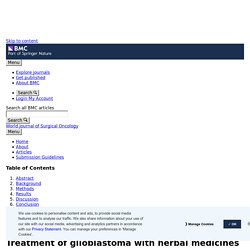
As a second-line therapy (so-called rescue therapy), chemotherapy with temozolomide (TMZ) had been commonly used, and it is the only effective drug in the treatment of recurrent glioblastoma [22]. Amazing Discovery: Plant Blood Enables Your Cells To Capture Sunlight. Evolution: It’s all in how you splice it. When genes were first discovered, the canonical view was that each gene encodes a unique protein.

However, biologists later found that segments of genes can be combined in different ways, giving rise to many different proteins. This phenomenon, known as alternative RNA splicing, often alters the outputs of signaling networks in different tissues and may contribute disproportionately to differences between species, according to a new study from MIT biologists. After analyzing vast amounts of genetic data, the researchers found that the same genes are expressed in the same tissue types, such as liver or heart, across mammalian species. However, alternative splicing patterns — which determine the segments of those genes included or excluded — vary from species to species. “The core things that make a heart a heart are mostly determined by a heart-specific gene expression signature.
Lead author of the paper is MIT biology graduate student Jason Merkin. A variety of proteins New functions. In 1886, the US Government Commissioned 7,500 Watercolor Paintings of Every Known Fruit in the World: Download Them in High Resolution. T.S.
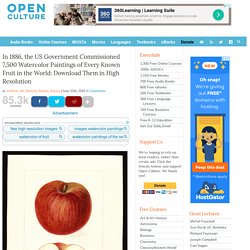
Eliot asks in the opening stanzas of his Choruses from the Rock, “where is the knowledge we have lost in information?” The passage has been called a pointed question for our time, in which we seem to have lost the ability to learn, to make meaningful connections and contextualize events. They fly by us at superhuman speeds; credible sources are buried between spurious links. Truth and falsehood blur beyond distinction. But there is another feature of the 21st century too-often unremarked upon, one only made possible by the rapid spread of information technology. Those archives include the USDA Pomological Watercolor Collection, “over 7,500 paintings, drawings, and wax models commissioned by the USDA between 1886 and 1942,” notes Chloe Olewitz at Morsel.
Higgins saw the project as an example of “the way free speech issues intersect with questions of copyright and public domain,” as he put it. It’s easy to see how Higgins could become engrossed in this collection. Via Morsel. Genomic Insights. Nutritional. Plants.